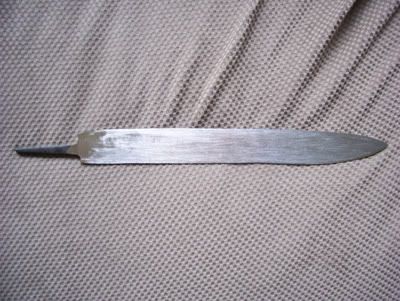|
-
4th March 08, 07:05 PM
#1
Handmade Scramasax
Well, not completely hand made. I'm making it out of a file, but it's turning out nice so far. But I had a question for anyone who knows about Scramasax's.
Were they double-edged knives, or single edged? I'm leveling it out right now, and it's almost time to put an edge on it before I polish. Also, does anyone have a recommendation as to what kind of wood to use for the handle?
-
-
4th March 08, 07:17 PM
#2
Almost across the board the scramasax was a single edged weapon.
Jay
Clan Rose - Constant and True
"I cut a stout blackthorn to banish ghosts and goblins; In a brand new pair of brogues to ramble o'er the bogs and frighten all the dogs " - D. K. Gavan
-
-
4th March 08, 07:20 PM
#3
All the orginal ones I've seen were single edged. Here's a couple links regarding the Seax
http://en.wikipedia.org/wiki/Scramasax
http://en.wikipedia.org/wiki/Thames_scramasax
Can't wait to see pic's of the finished weapon! 
[SIZE="2"][FONT="Georgia"][COLOR="DarkGreen"][B][I]T. E. ("TERRY") HOLMES[/I][/B][/COLOR][/FONT][/SIZE]
[SIZE="1"][FONT="Georgia"][COLOR="DarkGreen"][B][I]proud descendant of the McReynolds/MacRanalds of Ulster & Keppoch, Somerled & Robert the Bruce.[/SIZE]
[SIZE="1"]"Ah, here comes the Bold Highlander. No @rse in his breeks but too proud to tug his forelock..." Rob Roy (1995)[/I][/B][/COLOR][/FONT][/SIZE]
-
-
4th March 08, 07:22 PM
#4
Definitely single edge. Remember it was a tool probably more than a weapon so it needs the strength of a wider side.
-
-
4th March 08, 07:27 PM
#5
Single edge usually, however it's about a toss up as to which edge. Some were done on the curved side, some on the flat.
-
-
4th March 08, 08:35 PM
#6
I've seen both double and single edged. What makes it, for me, is the overall shape.
-
-
4th March 08, 10:56 PM
#7
the traditional woods oif choice seem to be birch and oak, i usually use red oak from lowes/home depot cuz it's cheap and easy to get. if you look hard enough you can find spalted or figured boards without paying a premium markup...hope this helps...ozzy
-
-
5th March 08, 07:08 PM
#8
More links
Here's some more info on the Seax that I found on myarmoury.com that you might find of interest (the last link has a number of artifact pictures):
Sax (or Seax)
A large war knife with a blade having a straight back, a single cutting edge, and a point of varying shape. In many cases the grip was set slightly to the rear, toward the back of the blade. Its size varied a great deal, ranging from that of a dagger (about 12-16") to that of a sword (33-40"). This large knife-which is regions north of the Alps was used as a domestic implement, a weapon of war (a scramasax), and, according to some experts, as a throwing weapon-derived from a very similar weapon made of bronze and widely used in the Hallstatt period (900-500 B.C.) to the beginning of the Christian era) in an iron version. It was one of the national weapons of the Saxons, who at the time of the migrations (4th-6th centuries) carried it in a sheath on their left side and, at least up until the early Middle Ages, alongside the sword. Examples have been unearthed in the warrior tombs of various Germanic people, which clearly shows its wise distribution.
With the advent of cavalry, the large sax disappeared from the warrior's armament and was relegated to the task of a domestic implement; the smallest type became a knife, which, together with the sword and the spear, was part of the horseman's weaponry in the field. In an intermediate version it survived throughout the Middle Ages as a hunting knife.
Scramasax (or Scramaseax)
A term used for the first time by Gregory of Tours (6th century), and later in various Visigoth legislative documents which lists weapons and includes the scramasax among the weapons issued to warriors. The etymology of the word (scrama, causing injury, and sax, [war] knife) suggests that it was a particularly offensive type of sax. But the precise meaning of the term is unclear.
http://www.myarmoury.com/feature_euroedge.html#sax
The Anglo Saxon Broken Back Seax:
http://www.myarmoury.com/feature_seax.html
[SIZE="2"][FONT="Georgia"][COLOR="DarkGreen"][B][I]T. E. ("TERRY") HOLMES[/I][/B][/COLOR][/FONT][/SIZE]
[SIZE="1"][FONT="Georgia"][COLOR="DarkGreen"][B][I]proud descendant of the McReynolds/MacRanalds of Ulster & Keppoch, Somerled & Robert the Bruce.[/SIZE]
[SIZE="1"]"Ah, here comes the Bold Highlander. No @rse in his breeks but too proud to tug his forelock..." Rob Roy (1995)[/I][/B][/COLOR][/FONT][/SIZE]
-
-
5th March 08, 10:12 PM
#9
I play a 10th century viking in the sca and am a thrown weapons enthusiast ( spear, axe, and knife). i've made about ten seaxes over the years as reenactor knives but none as throwers...i prefer working knives to be tempered and a tempered knife is just too brittle at the edge to put up with the extreme stresses of being hurled at a chunk of tree...the cheap leaf bladed throwers are crap but well suited to a "use it and lose it" approach...besides most handle materials will not stand up to throwing, a notable exception beng leather strips bolted or riveted on...ozzy
-
-
7th March 08, 06:44 PM
#10
Here's a picture of the blade thus far.

I think I'm going to elongate the longer curve a little more. Right now I'm leveling both sides of the blade. Then I'll put an edge on it and polish it 'till it's nice and shiney.
I've been looking at some burled woods, but I think they're a little too fancy for an ancient knife.
-
Similar Threads
-
By breacan in forum DIY Showroom
Replies: 32
Last Post: 5th June 07, 09:01 AM
 Posting Permissions
Posting Permissions
- You may not post new threads
- You may not post replies
- You may not post attachments
- You may not edit your posts
-
Forum Rules
|
|

















Bookmarks